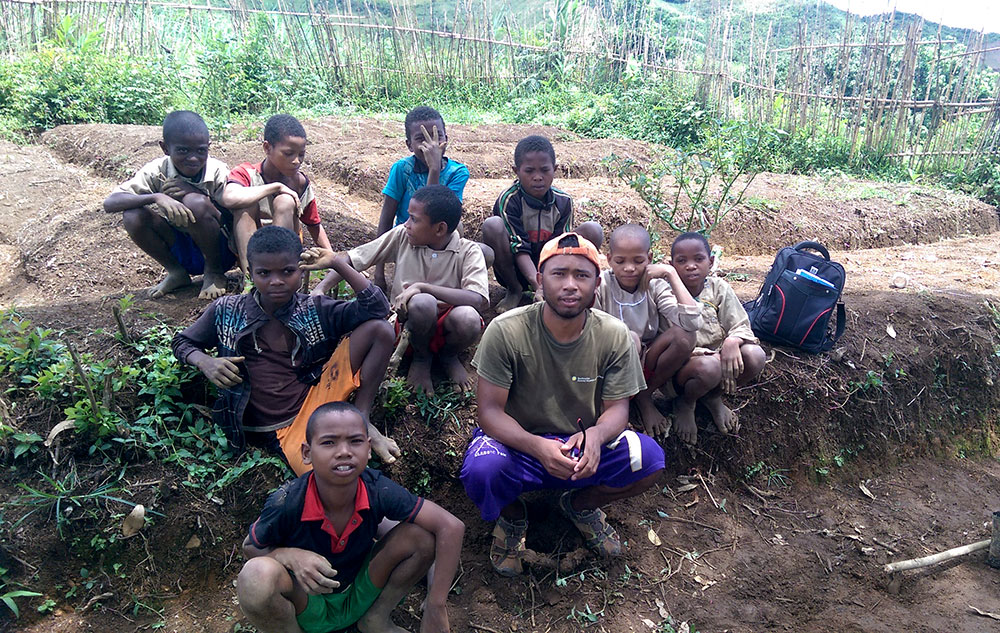April 5, 2018
As someone who travels for the Zoo, developing conservation action projects and working on strategic partnerships, I am constantly amazed by the people I meet, their passions, and their drive for a better, more sustainable world.
The 2016 One Cubic Foot trip to Madagascar was no different. One of the people I met on that trip was Mahandry Hugues Andrianarisoa. Mahandry was assigned to us as a requirement for our permits to conduct research in the country. When I met Mahandry, he told me he was most interested in working on conserving the fossa, a secretive carnivore that lives on the island.As we worked on the project, we asked Mahandry about his story. He told us he has never seen trees in his hometown, and only through his dad’s stories did he even know there used to be trees there. I thought about the trees, in the yard of my childhood home, which just a few years ago were 25-30 feet tall. The trees that my father planted, their growth seen through multiple childhood photos in our family photo album of trees growing exponentially quicker than us kids. I tried to imagine not having that memory, and honestly, I couldn’t do it. How do we imagine not having something that is so deeply embedded in our lives? Living in the Northeast, we have always seen vast expanses of forests and trees.As Mahandry was telling us his story, I reflected on our 10-hour trip to the field station. Vast amounts of terraced rice fields, and every once in a while, a plot of land that had an acre or more of trees on it. The silence that occurs with no tree diversity is deafening as you travel the landscape of Madagascar. The small plots of trees that are there are like islands. Islands that biodiversity searches for in a vast sea of subsistence farms and hundreds and hundreds of small fires. Fires that represent families with no food security, income, or any other way of living.As we continued our project, it was heartening to see Mahandry’s eyes opened to the world that was right before him. He went from focusing on a large mammalian species, to living in the minute species. The same way we see Rochester school kids becoming connected to nature through our One Cubic Foot ZooMobile, we saw Mahandry’s appreciation for the interconnectedness of it all.
What made this more powerful was the place where this transformation was happening – Ranomafana National Park. A young park – only 25 years old – Ranomafana is also a young forest. Most of the park is reforested and regenerated. And in a short 25 years, we were finding some amazing biodiversity already returning and residing in the forest. As the week went on, Mahandry told me his true dream.
He told me that if he could, he would work on reforesting. He didn’t know the way to do that. We talked a lot. Mahandry said he dreamed of coming to the United States. He dreamed of becoming a director of a National Park. I am not sure how much Mahandry dreamed before, or how many times he actually shared that dream with anyone.Fast forward a year, and Mahandry was spending time at the Smithsonian Museum of Natural History and at Seneca Park Zoo, receiving training and seeing conservation from “our side of things”. While he was here, Pat Wright, the Zoo’s partner from Stony Brook University, offered Mahandry a supporting role in the reforestation project happening out of the field station we stayed at in Madagascar.
In February of this year, through support from Seneca Park Zoo Society and our Docents, Mahandry traveled the same trip I had taken a year and a half ago. Through the barren, but beautiful landscape from Antananarivo south to Ranomafana. Through countless subsistence farms, towns with no electricity, and hundreds of small fires. This trip was different though, as Mahandry was on his way to begin reforesting this landscape.
In the short two-months he has been on the job, Mahandry has moved from training to action. Just a few weeks ago, he set out on a week-long excursion to assess the nurseries in the area as well as to search for ideal trees to propagate. On this first trip, Mahandry’s project planted 3,000 trees. Mahandry has begun to give a new generation of Malagasy kids the same experience I had as a child. And I am incredibly proud to know that Seneca Park Zoo had a role in that experience.– Tom Snyder, Director of Programming and Conservation Action








